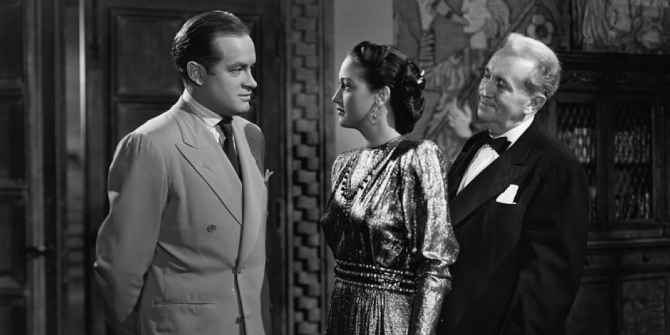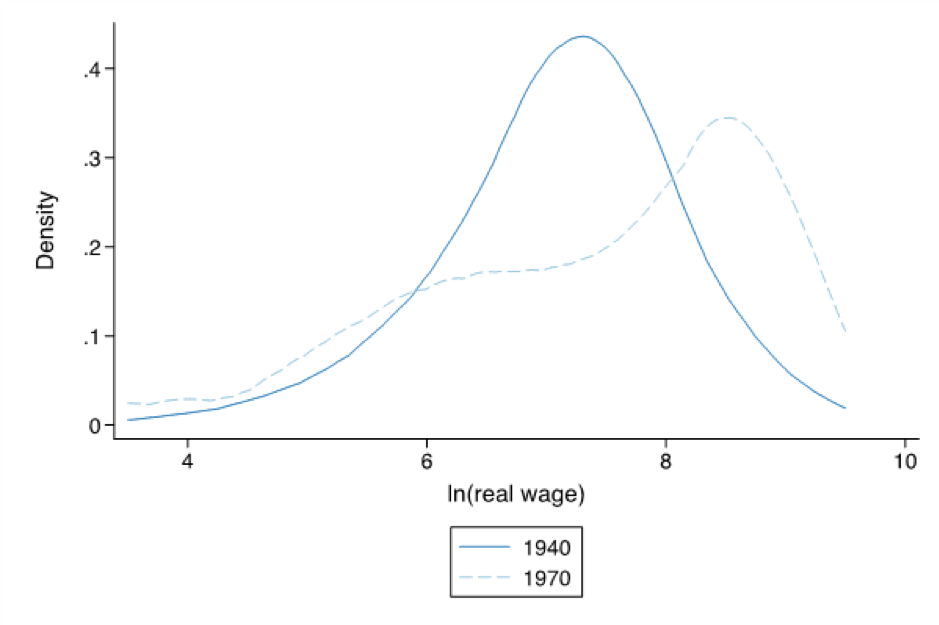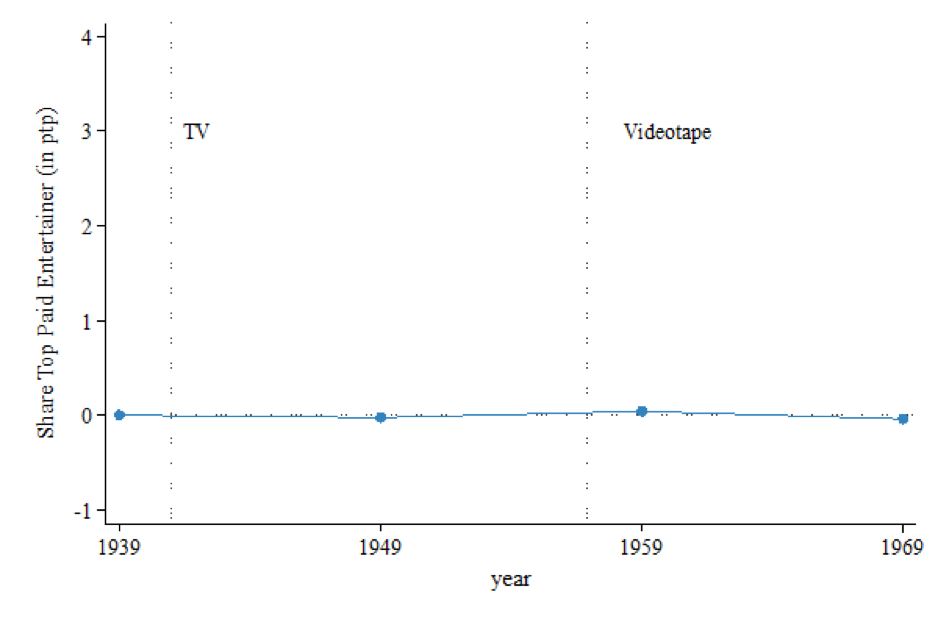
Technical change is disrupting many labour markets and is re-shaping the world of work. A widespread fear is that new technologies generate winner-take-all labour markets that benefit a small group of superstars, at the expense of the majority of the workforce. These so-called “superstar effects” arise when technologies open up bigger markets and make it possible to reach consumers in larger, perhaps even global markets. While this argument that rising inequality is driven by technical change is popular, there is still very little evidence that technologies are contributing to the explosion of top incomes and are creating “superstar effects.” The historic experience with the impact of market opening technologies can help us to test this theory and uncover the consequences of such developments for labour markets.
The US entertainment sector experienced an iconic technological disruption during the roll-out of television in the middle of the 20th century. The new medium multiplied the audiences of entertainers many times over. And while before the launch of TV a live performance could be watched by a few hundred individuals, its introduction meant that the same performance could be watched by millions. From the earliest days of television, people flocked away from traditional amusement in theatres, bars, bowling alleys, vaudeville palaces or sports events and became glued to their sets.
The introduction of television increased entertainers’ income inequality
During this period, inequality in the entertainment sector increased sharply. Figure 1 shows the earning distribution in entertainment before and after the launch of television. Incomes at the top end of the distribution grew, while the share of mid-paid jobs declined, and the low paid sector grew in size. As a consequence, the earnings distribution stretched out at both ends of the distribution and income differences grew sharply. During the 1950s and 1960s this rise in inequality in entertainment was an outlier; in the wider US economy inequality did not change much during this period. The unusual development in entertainment suggests that technical change may have an important effect on inequality.
Figure 1. Change in entertainer wage distribution 1940 – 1970

Notes: The figure shows the entertainment log real wage distribution in 1940 and 1970 from the lower 48 states. Dollar values are in 1950 USD. Density is estimated using the Epanechnikov smoothing kernel with a bandwidth of 0.4 and Census sample weights. Common top code applied at $85,000. Sources: US Census 1940, 1970.
It would, however, be premature to conclude from the coincidence of technical change and rising inequality that the change in the inequality is driven by technical change. Other changes occurred at the same time and also affected labour markets, for instance, changes in regulation and pay-setting processes. Aggregate wage trends hence reflect a variety of simultaneous trends, which makes it difficult to isolate the impact of technical change, a challenge that is also important in the debate about the impact of current technologies. A scientific approach would be to run a test that randomises access to technology across labour markets. This is rarely possible, so researchers instead use natural experiments, for example, those which are generated by existing regulation, to generate random differences in technology access across labour markets.
How we can tell that television led to income changes
The roll-out of television provides such a natural experiment and thus gives us a rare opportunity to isolate the impact of a technical disruption on the labour market. Television filming initially started city by city, which meant that places experienced this technical change at different times. Filming in the early period of television predominantly took place locally in the neighbourhood of the broadcast station and hence, from the perspective of a local entertainer, the launch of a local TV station was similar to the construction of a giant local theatre that could hold the entire local population.
Two factors of the deployment of TV generate useful variation in TV access to isolate the impact of TV on inequality. First, the TV was deployed through a regulated process by the Federal Communications Commission (FCC) which developed a rule-based deployment mechanism without regard to local economic conditions. Second, the roll-out plan was interrupted when the signal of neighbouring stations started interfering. Several local labour markets thus narrowly missed out on TV launches, which generates as good as random variation in television access. This type of natural experiment makes it possible to differentiate the effect of technology from changing local economic conditions and test the implications for inequality.
The results reveal that television had substantial effects on inequality in entertainment. Places where television was deployed experienced sharp income gains for star entertainers. Having a local TV station boosts pay at the 99th percentile by around 17 per cent, a big gain for entertainer stars relative to other top earners in the US. The share of local entertainers in the top 1 per cent of the US wage distribution nearly doubles relative to the pre-TV era. Figure 2 shows that this occurs in locations where a local TV station is launched and disappears again when centralised network filming displaces local filming. We can then turn to the deployment interruption to verify that the launch of TV stations is unrelated to other trends in local labour markets. And indeed, the data show that locations which narrowly miss out on the launch of a TV station see no growth in top entertainer pay (Figure 2.b). This lack of effects in places that miss out bolsters the confidence that the baseline results capture the effect of television.
Figure 2. Effect of TV on top earners
A. Blocked TV stations

B. Active TV stations

Notes: Figure 2 plots treatment coefficients from two dynamic difference in differences regressions. Panel a) shows the effect of blocked TV stations (comparison groups are untreated areas) and panel b) shows the effect of TV stations. Top-paid entertainers are in the top 1 percent of the US income distribution. Vertical lines mark the beginning of local TV (“TV”) and the end of local TV (“videotape”). The area shaded in light blue marks the 95 per cent confidence interval. Standard errors are clustered at the local labour market level.
TV’s roll-out only benefitted a small number of top entertainers
Economists have argued that superstar effects magnify the rewards from being the best but offer limited gains outside of a small group of top stars. These characteristic patterns of superstar effects are strongly supported in the data. Income growth escalates as we move up towards the top of the wage distribution and the share of income going to the top 1 per cent nearly doubles. Marginally less talented workers don’t benefit from television. Gains accrue to a few entertainers in the top tail, while the fraction with mid-income jobs declines.
Looking beyond the stars, the roll-out of television has substantial negative effects on a large part of the entertainer workforce. I use a TV signal propagation model to compute which local entertainers must compete with the shows broadcast over airwaves. In the initial roll-out period, many parts of the country did not have access to television signal. Interest in local entertainment declined substantially when television signal became available. Comparing demand for local entertainment across areas with and without signal throughout the roll-out reveals the devastating impact of television. Spending at local county fairs declined 5 per cent and employment in the local entertainment industry dropped by about 13 per cent.
A key driver of these superstar effects is competition for talent. The data show that labour markets with limited competition among employers only produced muted top income growth. Income concentration on a few stars does therefore not necessarily imply that markets are malfunctioning, instead, the superstar effects arise as a result of intense competition for talent. This suggests that addressing imperfect competition in labour markets did little to reduce rising top income concentration.
Good for consumers, bad for most entertainers and traditional live shows
Does this rise in inequality reflect unequal gains in productivity? Productivity can be uniquely well measured in the entertainment sector. I collected archival data on audiences of entertainers and prices and track how these changed during the TV roll-out. The data show that revenues of stars’ shows grew strongly when local television stations were launched, while ordinary live shows suffered a sharp drop in revenues. Audiences of star entertainers quadrupled, and revenues simultaneously grew in line with the audience size. At the same time, attendance and spending at traditional live entertainment outlets dropped significantly. This effect was particularly pronounced for live performances that stood in direct competition with television, while entertainment outlets that were more immersive and distinct from television were more shielded from the disruption. These results show that the shift in labour market inequality was underpinned by a simultaneous change in productivity.
The results of one of the most iconic cases of a scale related technical change confirm that technologies can cause sharp income inequality and generate “superstar effects.” In the labour market for entertainers, TV multiplied incomes of superstars and moved the labour market closer to a winner-takes-all setting. Incomes became concentrated on a handful of stars, while it hurt most workers. These effects were most pronounced in labour markets where competition for talent was strongest and reflected a simultaneous shift in revenues that such stars could generate through the new media. Besides the rise in inequality, television also changed access to entertainment for consumers and TV turned out to be hugely popular. This highlights the trade-off that technical change can generate. While such change may improve consumer welfare, on the one hand, it simultaneously can generate substantial increases in inequality. The merit of technological change ultimately depends on the relative importance one attaches to consumer gains and labour market inequality. In the long-run changes in occupational choices can help to buffer the inequality effects of technological change, but the long list of starlets and aspirational stars suggests that the glory of stardom still attracts many to this labour market despite the low odds of success.
Beyond the entertainment sector, many current technologies are making it feasible for workers to reach vast scale markets. While there are parallels to the entertainment case, superstar effects arise only when workers have unique and irreplaceable talents. In labour markets where skills are learnable and workers are closer substitutes, superstar effects are likely smaller. Consequently, efforts to make it easier to substitute between workers can help to reduce the rise of inequality.
♣♣♣
Notes:
- This blog post is appeared first on LSE USAPP. It is based on ‘Technical Change and Superstar Effects: Evidence from the Roll-Out of Television‘, Discussion Paper of LSE’s Centre for Economic Performance (CEP).
- The post expresses the views of its author(s), not the position of LSE Business Review or the London School of Economics.
- Featured image: Bob Hope, Dorothy Lamour and John Hoyt, via skeeze, under a Pixabay licence
- When you leave a comment, you’re agreeing to our Comment Policy
 Felix Koenig is a postdoctoral researcher at Princeton University and incoming Assistant Professor at Carnegie Mellon University. He is also an associate of the LSE’s Centre for Economic Performance and an affiliate at IZA. Felix’ research focuses on labour markets and in recent projects he studies the causes and consequences of rising inequality.
Felix Koenig is a postdoctoral researcher at Princeton University and incoming Assistant Professor at Carnegie Mellon University. He is also an associate of the LSE’s Centre for Economic Performance and an affiliate at IZA. Felix’ research focuses on labour markets and in recent projects he studies the causes and consequences of rising inequality.





